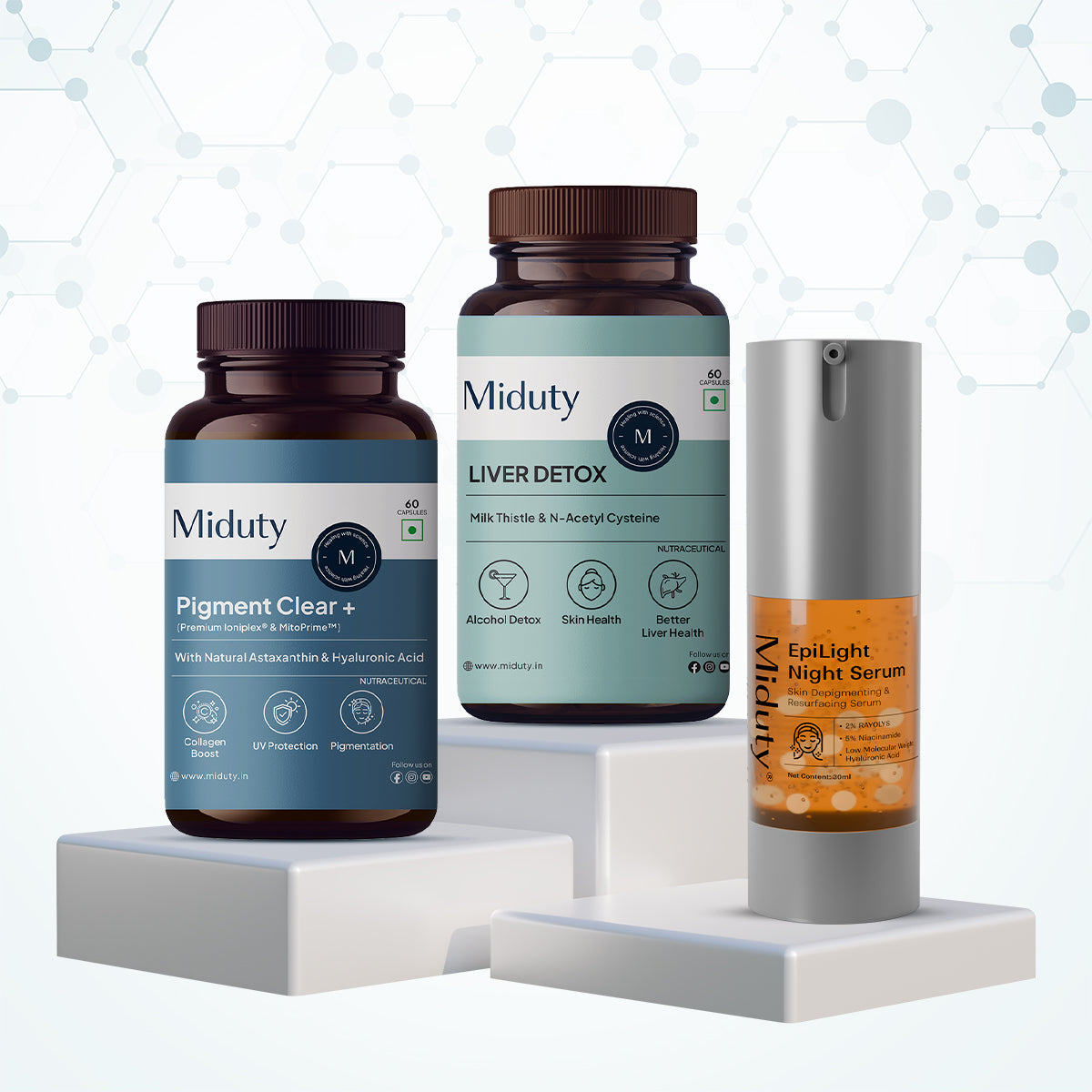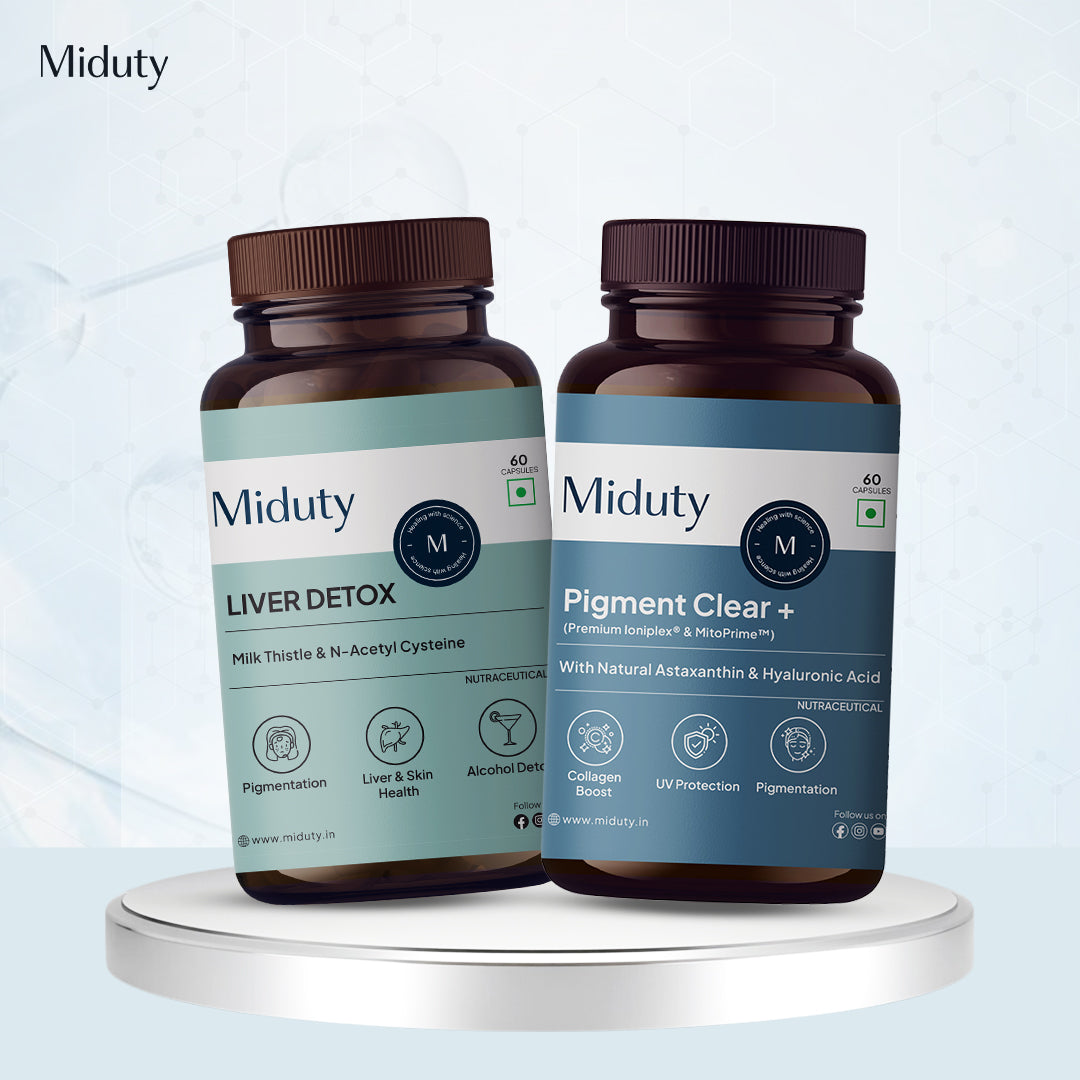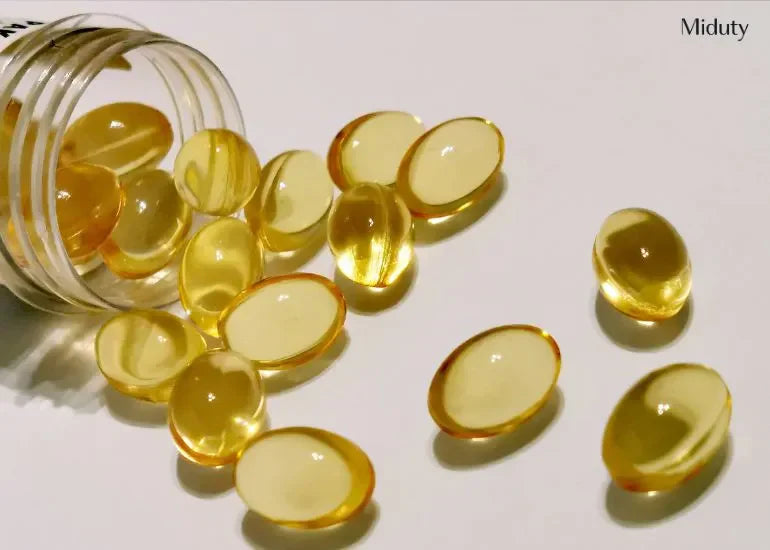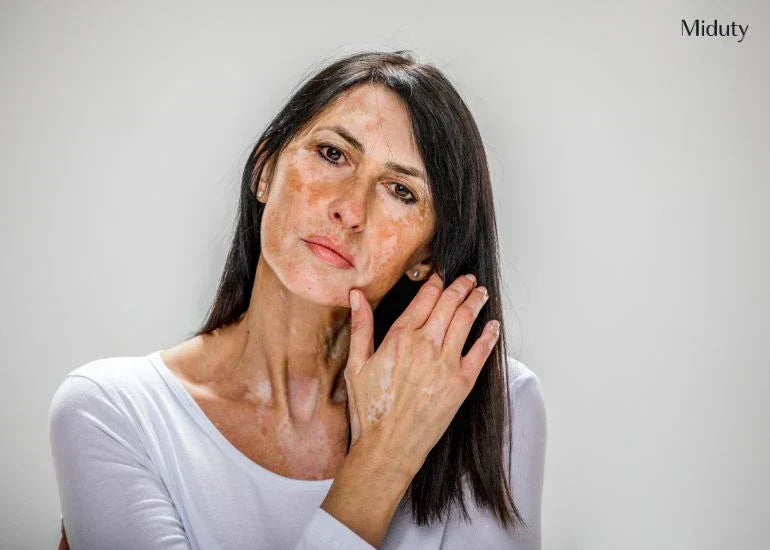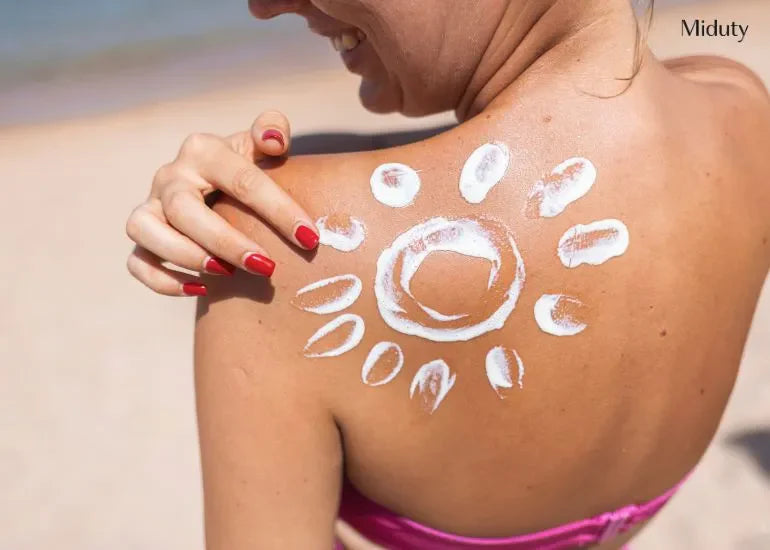
How to Get Rid of Sun Tan: Natural Remedies, Prevention Tips & Skincare Routine Explained
Whether it's a vacation tan, uneven patches on your arms, or that stubborn darkness on your neck - sun tan isn't just about appearance. It's your skin's defense mechanism against damage. But here's the truth most people don't realize: a tan isn't a sign of health; it's a sign of stress specifically, oxidative stress caused by UV radiation.
Contrary to popular belief, tanning involves more than just melanin production. UVA and UVB rays can lead to long-term skin damage, collagen breakdown, premature aging, and pigmentation that doesn't fade easily. That's why removing a tan safely and more importantly, preventing it in the first place requires a deeper understanding of skin biology, not just home remedies.
In this guide, we'll break down science-backed methods, dermatologist-approved ingredients, and effective home treatments that actually work. Whether you're looking to reduce an existing tan or protect your skin from future damage, this is your go-to resource for healthy, radiant, and even-toned skin, all year round.
Key Takeaways
1. A tan is actually your skin's stress response, not a sign of good health. When your skin darkens, it's producing melanin to protect itself from harmful UV rays. So, sun tan is an early warning sign of damage, not a beauty boost.
2. Even high SPF sunscreens don't offer complete protection. SPF 50 blocks about 98% of UVB rays but not all UVA rays. That's why combining sunscreen with antioxidants like Vitamin C or Polypodium leucotomos can provide better sun defense.
3. You can develop a tan indoors, especially near windows. UVA rays can penetrate glass, meaning you're still exposed while driving, sitting by a window, or working near natural light. This is a common cause of forehead and arm tanning.
4. Tanning on arms and legs lasts longer because the skin is thicker. The outer layer of skin on limbs is denser, which means tan builds up deeper and takes more time (and effort) to fade.
5. Home remedies may offer relief, but science-backed ingredients are more effective. While ingredients like curd and lemon offer temporary brightness, active ingredients like niacinamide, glycolic acid, and retinoids show better long-term results in reducing sun tan, especially from targeted areas like hands, forehead, and arms.
What is a Sun Tan?
A sun tan is your skin's natural defense mechanism against the ultraviolet (UV) rays of the sun. When exposed to sunlight, your skin produces more melanin: the pigment responsible for your skin tone, to absorb and diffuse UV radiation. This darkening is essentially your skin's "shield" against deeper damage, but it's also a visible sign of stress on your skin.
Tanning can look different depending on skin type. Fairer skin may burn before tanning, while deeper tones tend to tan more evenly but still face risks like hyperpigmentation and premature aging. Importantly, tanning doesn't happen evenly, some areas like your forehead, arms, and hands darken faster than others, leading to patchy skin tone.
While some may view a tan as a "healthy glow," in reality, it's a form of skin injury. Over time, repeated tanning accelerates aging, causes pigmentation issues, and increases the risk of skin cancer.
Causes of Sun Tan
When your skin is exposed to the sun, it produces melanin, the pigment responsible for your skin color. This is your body's way of protecting deeper layers of skin from UV radiation, particularly UVA and UVB rays.
UVA vs. UVB:
- UVA rays penetrate deeper and cause long-term damage, including pigmentation and wrinkles.
- UVB rays cause surface burns, leading to redness and visible tanning.
According to a 2020 study published in the Journal of Investigative Dermatology, excessive exposure to UVA and UVB rays not only increases melanin but can also lead to oxidative stress and inflammatory responses, which slow down skin's natural recovery process.
Other Common Causes of Sun Tan:
1. Spending long hours outdoors without applying sunscreen.
2. Reflective surfaces like sand, water, or snow intensifying UV exposure.
3. Living in or visiting regions near the equator, where the sun's rays are more direct.
4. Using tanning beds, which emit high concentrations of artificial UV radiation.
5. Even on cloudy days, up to 80% of UV rays still reach your skin, making tanning possible year-round.
How Sun Tanning Affects Your Skin?
Tanning might give your skin a sun-kissed glow, but it comes at a cost. When UV rays hit your skin, they damage collagen and elastin — the proteins responsible for keeping it firm and youthful. This damage can lead to early signs of aging like wrinkles, fine lines, and sagging.
It doesn't stop there. UV exposure also creates free radicals that harm skin cells and DNA, increasing your risk of dark spots, uneven skin tone, and even skin cancer over time. Fair or sensitive skin types are especially vulnerable, often burning instead of tanning.
In short, that temporary tan could lead to lasting harm. So, avoiding and treating sun tan isn't just about aesthetics — it's essential for protecting your skin's long-term health.
How to Get Rid of Sun Tan?
Reducing sun tan starts with helping your skin renew itself while preventing further UV damage. It's not about scrubbing your skin raw — it's about smart, consistent care. Here are three effective ways to fade tan naturally and safely:
1. Use Alpha Hydroxy Acids (AHAs)
AHAs such as glycolic acid and lactic acid are mild exfoliants that work by loosening the bonds between dead skin cells. This helps slough off the top, tanned layer and encourages fresh, evenly-toned skin to emerge. Unlike physical scrubs, AHAs are gentle and don't cause micro-tears, making them ideal for regular use. You'll start seeing smoother, brighter skin in just a few weeks of consistent application.
2. Add Vitamin C to Your Routine
Vitamin C is a game-changer when it comes to reducing pigmentation and sun damage. As a potent antioxidant, it neutralizes free radicals caused by UV exposure and inhibits melanin production — the main culprit behind tanning. Applying a vitamin C serum daily helps brighten dark spots, even out your skin tone, and boost collagen, giving your skin a healthy, radiant glow. For best results, use it in the morning under sunscreen.
3. Never Skip Sunscreen
No matter how many tan-removal treatments you use, skipping sunscreen will undo your progress. A broad-spectrum sunscreen with SPF 30 or higher is essential — not just when you're outside, but even indoors where UV rays can enter through windows. Apply it generously on all exposed areas like your face, neck, arms, and legs, and reapply every 2–3 hours if you're outdoors. Sunscreen not only prevents further tanning but also shields your skin from premature aging and sunburn.
With these three steps — gentle exfoliation, antioxidant-rich skincare, and consistent sun protection — you'll be well on your way to reversing tan and restoring your skin's natural tone.
Natural Remedies for Reducing Sun Tan
Let's talk about the DIY route. Some home remedies for sun tan can be helpful when used consistently. Just remember—results take time, and it's always best to patch-test first.
1. Curd and Honey Pack
Curd is rich in lactic acid, which helps exfoliate dead skin cells and brighten the complexion. Honey, with its soothing and antibacterial properties, helps calm sunburned skin and lock in moisture.
How to Use
- Mix 2 tablespoons of plain curd with 1 tablespoon of raw honey.
- Apply the mixture evenly to tanned areas.
- Let it sit for about 20 minutes, then rinse with lukewarm water.
- Use this remedy 3–4 times a week for best results.
This mask not only helps fade tan but also leaves your skin soft, hydrated, and refreshed.
2. Tomato and Lemon Juice
Tomatoes contain lycopene — a powerful antioxidant that helps reduce redness and repair sun damage. Lemon juice is rich in vitamin C and citric acid, which can help lighten pigmentation and even out skin tone.
How to Use
- Mix equal parts of fresh tomato juice and lemon juice.
- Apply the solution to the affected areas using a cotton ball.
- Leave it on for 10–15 minutes, then rinse off with cool water.
Note: Lemon juice can be irritating to sensitive skin or broken skin. If you have sensitive skin, skip the lemon or dilute it heavily with tomato juice or rose water.
3. Aloe Vera Gel
Aloe vera is a go-to remedy for any kind of skin irritation, including sunburn and tanning. It cools, soothes, and hydrates the skin while also promoting cell regeneration.
How to Use
- Scoop out fresh aloe vera gel from the plant (or use pure, store-bought gel with no additives).
- Apply a thick layer to the tanned areas.
- Leave it on overnight, or for at least 30 minutes before rinsing.
Daily use of aloe vera not only helps fade tan but also improves overall skin health and reduces redness or inflammation.
Different Body Areas Where Sun Tan Happens the Most
1. Face
The face is the most exposed part of your body and is constantly in contact with the sun — whether you're walking outdoors, driving, or just sitting by a window. Because of this daily exposure, the face often shows early signs of tanning, including dark spots, uneven skin tone, and fine lines. Tanning here can make the skin look dull and aged.
How to Remove
- Apply aloe vera gel every night to calm and heal the skin.
- Use a vitamin C serum in the morning to brighten and reduce pigmentation.
- Follow up with a broad-spectrum sunscreen every single day.
- Gently exfoliate once or twice a week to remove dead skin cells.
2. Arms and Hands
These areas are often forgotten in skincare routines but are among the first to show signs of tanning — especially for those who drive often. The forearms and hands are directly exposed to sunlight on a daily basis, leading to visible tan lines and darkening.
How to Remove
- Apply a lemon juice and honey mask 3–4 times a week. Lemon lightens while honey moisturizes.
- Always apply sunscreen before heading outdoors, even if you're just commuting.
A 2021 study in Dermatologic Therapy found that kojic acid, when used for 4 weeks, significantly reduced pigmentation on forearms.
3. Neck
The neck is often neglected when applying skincare or sunscreen, resulting in a noticeable contrast in color between the face and neck. The skin here can become tanned, dry, and uneven, especially along the sides and the back.
How to Remove
- Extend your face care routine to your neck — cleanse, tone, moisturize, and apply SPF.
- Apply a multani mitti (Fuller's earth) and rose water mask twice a week to lighten and refresh the skin.
4. Feet
Sandal tans and sunburns on the feet are a common problem in summer. The tops of the feet, especially around the toes, can develop stubborn tan lines due to direct exposure and lack of protection.
How to Remove
- Soak your feet in warm water with lemon juice for 10–15 minutes to loosen tanned skin.
- Use a pumice stone to gently scrub the area and remove dead skin.
- Moisturize afterward to prevent dryness and maintain smooth skin.
5. Back and Shoulders
These areas are highly exposed during outdoor activities like swimming, beach outings, or sports, especially if you wear sleeveless or backless clothing. The back and shoulders tend to tan quickly and can become patchy or dry if not properly cared for.
How to Remove
- Apply aloe vera gel or cooling clay-based body masks to soothe and lighten the skin.
- Use UV-protective clothing or swimwear during prolonged sun exposure.
According to a study in The Journal of Clinical and Aesthetic Dermatology, azelaic acid at 15–20% concentration significantly lightened facial hyperpigmentation within 6 weeks.
By addressing these specific areas with targeted care, you can effectively reduce tan and maintain a more even skin tone across your entire body. Prevention, combined with consistent skincare, is key to long-term results.
Skincare Routine to Prevent and Remove Sun Tan
Natural remedies are great, but consistency in skincare is where the real magic happens. A daily skincare routine tailored for sun-exposed skin can help remove existing tan and prevent further damage. It's not about using a hundred products — just a few right ones, in the right way.
Let's break it down:
Morning Routine
1. Cleanser – Use a gentle, hydrating cleanser that removes dirt and sweat without stripping your skin.
2. Exfoliator – 2–3 times a week, use a mild scrub to remove dead skin cells that deepen the appearance of tan.
3. Toner – Use an alcohol-free toner to restore your skin's pH and tighten pores.
4. Serum – Go for a vitamin C serum; it helps lighten pigmentation and boost collagen.
5. Moisturizer – Keeps the skin barrier healthy and hydrated.
6. Sunscreen – Use a broad-spectrum SPF 30 or higher daily, even when indoors.
Night Routine
1. Cleanser – Wash away the day's buildup.
2. Exfoliator or Mask (optional) – 2 times a week to speed up skin renewal.
3. Serum/Night Cream – Choose one with ingredients like niacinamide or retinol (if your skin can handle it).
4. Eye Cream – If needed.
5. Lip Balm – Don't forget your lips — they tan too!
Consistency is key here. You can't undo months of sun damage overnight. But with the right routine, you'll start to see brighter, healthier skin in just a few weeks. Think of it as a long-term investment in your skin's future.
When to Consult a Dermatologist?
Most tans fade on their own over time or with regular home care, but some cases require professional help. So, how do you know when it's time to book that derm appointment?
Here are signs you should consult a dermatologist:
- Your tan lasts longer than 3–4 months with no improvement.
- You notice dark patches or uneven pigmentation that's worsening.
- Home remedies irritate your skin or cause breakouts.
- Your skin feels constantly itchy, red, or inflamed after sun exposure.
- You spot moles or skin growths changing in shape or color – this could indicate skin damage or early signs of cancer.
Dermatologists can accurately assess your skin, identify any underlying issues (like melasma or sun allergies), and guide you with treatments tailored for your skin type. They can also prescribe medicated creams or procedures that work faster than over-the-counter options.
Lifestyle Changes to Avoid Future Sun Tanning
Preventing a tan is much easier than removing it. A few smart lifestyle habits can protect your skin from UV damage and keep it healthy year-round.
1. Daily Sunscreen Use
- Choose broad-spectrum SPF 30 or higher.
- Apply on all exposed skin: face, neck, ears, and hands.
- Reapply every 2–3 hours, especially after sweating or swimming.
- Opt for mineral sunscreens with zinc oxide or titanium dioxide.
2. Protective Clothing
- Wear wide-brimmed hats, UV-blocking sunglasses, and long sleeves.
- Choose light-colored, breathable fabrics that reflect sunlight.
- Carry a UV-protective umbrella when out for long periods.
3. Smart Sun Timing
- Avoid being outdoors between 10 a.m. and 4 p.m.
- Schedule outdoor activities in the early morning or late evening.
- Seek shade whenever possible.
These small changes help you stay tan-free while also protecting your skin from long-term damage.
Sun Protection for Preventing Future Tan
While treatments can help repair sun damage, the most important step is preventing tanning in the first place. Using a 100% chemical-free tinted mineral sunscreen with SPF 50 PA+++ is one of the most effective ways to do this. Formulated with Non-Nano Zinc Oxide, Squalane, Ceramides, and Radicare Gold, it offers broad protection against UVA/UVB rays, blue light, Wi-Fi, and infrared (IR) radiation. This gentle yet powerful formula is free from chemical filters, hormone-safe, and leaves no white cast—making it suitable for all skin types, even sensitive skin. For the best results, apply it over a moisturizer to maintain hydration, as pure mineral sunscreens can feel slightly dry when used alone.
Conclusion
Tanning is your skin's cry for help, not a sign of health. Whether it's sun tan on arms, legs, hands, or your forehead, getting rid of it requires a little patience, some consistency, and the right combination of skincare and sun protection.
If you're using home remedies for sun tan, be consistent and gentle. And if you prefer faster results, go for science-backed actives like Vitamin C, AHAs, or azelaic acid. And always, always wear sunscreen.
Now that you know how to reduce sun tan, your skin doesn't have to hold onto those patchy reminders of summer any longer.
Frequently Asked Questions on How to remove Sun Tan -
Q1 - How can I remove sun tan quickly?
To fade a sun tan quickly, start by exfoliating to shed dead, pigmented skin cells and apply natural brightening agents. For faster results, you can opt for professional treatments, while home remedies like lemon juice, aloe vera, or tomato pulp offer gentle alternatives. With regular exfoliation and consistent use of skin-lightening ingredients, the tan gradually lightens and your natural skin tone is restored.
Q2 - Can tanned skin become white again?
Yes, tanned skin can lighten and may return to its original shade, though the process takes time. A tan develops when your skin produces extra melanin to shield itself from sun damage. As your skin naturally renews and sheds dead cells, the tan gradually fades. To speed up the process, you can use exfoliation techniques and apply skincare products with skin-brightening ingredients, helping restore your natural tone more quickly.
Q3 - What does sun tan mean?
Yes, tanned skin can lighten and may return to its original shade, though the process takes time. A tan develops when your skin produces extra melanin to shield itself from sun damage. As your skin naturally renews and sheds dead cells, the tan gradually fades. To speed up the process, you can use exfoliation techniques and apply skincare products with skin-brightening ingredients, helping restore your natural tone more quickly.
Q4 - Are sun tans permanent?
No, a sun tan is generally not permanent. Tanning happens when the skin produces extra melanin to protect itself from UV radiation. This response is temporary, and as the skin naturally sheds and regenerates, the tan gradually fades over time.
Q5 - How many days are required to remove sun tan?
A mild sun tan can fade within a few days to a week when paired with proper skincare and sun protection. A moderate tan usually takes about two to four weeks to diminish, while a deep tan from prolonged sun exposure may last several months before completely fading. The duration largely depends on the intensity of the tan and the skin's natural renewal cycle.
References



